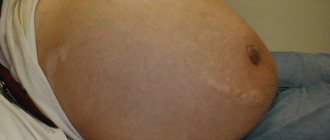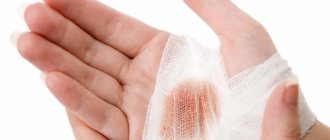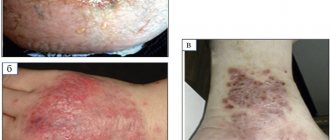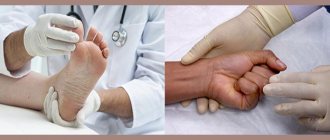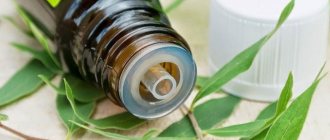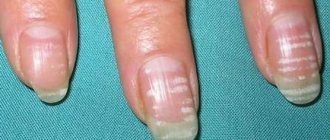Psoriatic skin lesions can develop in any person, regardless of gender, age and nature of work activity. Most often, the first symptoms of this disease appear in the age range from 15 to 25 years. Below we will discuss the symptoms and treatment of psoriasis on the hands, feet, head and nails, and will also give recommendations for preventing relapses of psoriatic disease.
Psoriasis on hands
Typically, the first specific plaques appear on the palms and elbows. Doctors and researchers have not identified a specific reason for their appearance. You need to understand that psoriasis on the fingers (photo), as well as on the legs, head and other parts of the body, is not contagious and is not transmitted by shaking hands or personal objects. However, this does not mean that there is no need to rush to treat the disease, as it is fraught with serious complications.
Psoriasis at an early stage on the hands is difficult to miss.
The onset of the disease is accompanied by quite striking symptoms. Typically, single red papules (spots that rise above the skin level) appear on the palms and between the fingers. The rash looks like a regular allergy, so patients rarely go to a dermatologist at this stage and wait until the problem goes away on its own.
With the development of psoriasis, the papules merge with each other, forming plaques, and are covered with gray scales. It is then that the characteristic signs of the disease appear. Subsequently, the lesions do not peel off as much and stop growing. However, they look very repulsive, which is why many people experience severe psychological difficulties.
In adults, plaques covered with gray-white scales on the elbows, fingers, hands and palms can resemble lichen or fungus; as a rule, psoriatic plaques have a clear border.
It is also worth noting that when the disease affects the fingers, in most cases it also affects the nails. As a result, the nail plates become deformed and split at the edges. Fingers affected by psoriasis swell, which is often accompanied by pain in the joint area. The disease develops similarly in children.
Early stage psoriasis on hands
Initially, psoriatic rashes appear as small, smooth, round papules. One of the main differences is their clear outlines. This is how early-stage psoriasis begins on the hands (photo), the causes of which vary.
After a few days, the rashes become covered with light scales. They peel and fall off easily. Then the disease progresses, the rash increases in size and takes up more and more space.
Psoriasis on the fingers of the initial stage in most patients begins in the folds between the fingers, where the most suitable environment for the disease develops.
In general, the initial stage is characterized by three main features:
- a red papule (spot) appears;
- if you scratch the papule and remove the scales, a shiny, thin film appears, and if you scrape the film, droplets of blood appear on it.
In addition, at the initial stage of psoriasis, patients complain of swelling of the joints, redness of the skin and inflammation in the area near the nails. As the disease progresses, the papules stop growing and the peeling decreases.
How psoriasis begins on the hands and its symptoms can be seen in the presented photo. But you should not diagnose yourself, as there is a chance that you will confuse it with other skin diseases.
Signs of psoriasis on the hands
Typically, signs of psoriasis in women's hands are most pronounced on the palms. In men, the disease manifests itself less frequently in this area. This form of psoriasis is the most difficult to treat, since the palms are constantly in contact with detergents and objects surrounding the person.
Characterized by sharply defined plaques, against which there are multiple pustular rashes (pustules). Subsequently, they dry out, forming scale-crusts. The initial stage of psoriasis on the hands in the photo can be confused with other diseases: for example, with eczema or mycosis. Therefore, doctors perform a biopsy to confirm the diagnosis.
Signs of the disease differ depending on the location of the inflammation. Let's talk in more detail about each of them.
Fingers
With this form of the disease, psoriasis begins first between the fingers (pictured). The skin peels and becomes inflamed. Often symptoms worsen with the arrival of cold weather (autumn, winter). Without treatment, the problem leads to serious consequences.
Brushes
A quarter of affected people suffer from this form of psoriasis. The symptoms are similar to finger lesions. Problem areas become rough and covered with a red crust, similar in appearance to a callus. The spot also itches and brings all sorts of discomfort to the person.
Palms
As we have already said, this is one of the most painful forms of psoriasis because the affected skin is very itchy. Due to severe itching, patients often cannot sleep, which can cause neurosis. Characteristic is the appearance of plaques, against which there are multiple pustular rashes (pustules). Subsequently, they dry out, forming scale-crusts.
Joints
This type of psoriasis is also considered one of the most severe. It affects the joints of the hands between the phalanges, and then spreads to other joints. At the same time, at the initial stage, the disease may not appear on the skin, although the patient may already have joint pain. Inflammation in the joints is accompanied by redness of the skin over the affected joints, swelling, pain, limited mobility, and morning stiffness.
Prevention: how to reduce the risk of relapse
Unfortunately, medicine currently does not know how to completely cure psoriasis. Therapy removes external manifestations and discomfort. But the risk of relapse is high. The situation is similar to oncology. Hereditary predisposition influences. But some people develop psoriasis, and some don’t. To reduce the frequency of manifestations, try to lead a healthy lifestyle: eat well, get enough sleep, and take care of your health. It would not be a bad idea to visit a dentist, endocrinologist, gastroenterologist or ENT specialist if there are problems with them. Carious cavities, inflammation of the tonsils and a large stomach can become provoking factors for a relapse. The longer the period spent in remission, the more effectively the body recovers and the lower the load on the immune system.
Psoriasis on the hands of children
In most cases, psoriasis on the hands of a child (pictured) occurs if one or both parents are predisposed to allergies and skin diseases. This tendency is transmitted genetically and may not manifest itself in any way until it is provoked by some factor. No one knows the exact reasons that provoke the development of the disease.
It is the hereditary theory of the occurrence of psoriasis in children that is supported by most doctors. It is believed that if one parent suffered from skin diseases, the child has a 25 percent chance of having the same problem. If both parents are prone to psoriasis, the child's chances of getting the disease reach 75 percent.
Provoking factors include stress, streptococcal infections, alcohol abuse, and medications.
Psoriasis is often combined with systemic diseases, including metabolic syndrome, type II diabetes mellitus, coronary heart disease, arterial hypertension, and pathology of the hepatobiliary system.
Whatever the cause of psoriasis, one thing can be said: this disease is not a superficial skin lesion. It indicates that the body has hidden underlying problems with internal organs.
If your family members have suffered from skin diseases, and especially psoriasis, you need to strictly monitor the child’s diet and diet, strengthen his immune system and maintain a healthy lifestyle. This will prevent the onset of the disease.
How does psoriasis develop on a child’s hands:
initial stage
The first psoriatic spots in young children are in many cases mistaken for a more common diathesis or allergy. Usually, in very young children, slight redness occurs first. The rash resembles round pimples of a red or pinkish hue. The rash remains smooth for several days, after which silvery, flaky scales form on it.
Progressive stage
This stage is characterized by an increase and fusion of spots. Peeling continues only in the middle of the spots, while they grow along the edges. The spots become red, itchy and inflamed. This stage can last two weeks or longer (up to several months). Then it goes into a regression stage, in which the spots stop growing and gradually disappear.
The disease can also affect the nails.
Attention! Many parents of children suffering from psoriasis are horrified by the fact that this chronic and rather painful disease can manifest itself throughout life. In this situation, the doctor must explain that if you follow a healthy regimen, eat right, use special cosmetics and avoid stress, then the disease may not manifest itself.
What causes?
The main risk factor for the development of psoriasis is hereditary disposition. In 40% of patients, immediate relatives suffer from the same disease.
Other causes of psoriasis of the toenails and fingernails include:
- nervous stress, emotional instability;
- living in a cool, dry climate;
- past infectious diseases;
- bad habits;
- malnutrition;
- frequent mechanical damage to the nail plate.
Nail psoriasis is a chronic disease that cannot yet be cured.
It consists of periods of remissions and exacerbations. Exacerbation attacks are caused by certain medications (lithium drugs, antidepressants, antimalarials, anticonvulsants, antibiotics), dietary errors, alcohol intake, nervous stress, and infections.
The risk of developing the disease does not depend on gender or age. It is not uncommon for a child to develop nail psoriasis, and even a newborn can suffer. In 75% of cases, parents or doctors discover the first signs of pathology in childhood before the age of 5.
Symptoms of psoriasis on the hands
Symptoms of psoriasis on the hands are accompanied by constant itching, which can be treated with proper treatment. If the patient scratches the rash, numerous wounds can be seen on his skin. Typically, such wounds heal much faster in children than in adults.
The main symptoms of psoriasis on the hands:
- the skin turns red and dries out;
- the affected area swells and thickens;
- psoriatic lesions crack;
- single spots merge and may appear in new places;
- peeling usually worsens in winter;
- if the disease is not treated, the fingers swell and become covered with thickened, painful plaques;
- nails quickly become damaged, change color (become yellowish or brown), crack and become stained.
Treatment of psoriasis on hands and nails
Treatment of psoriasis on the hands and its symptoms is considered difficult. Even during periods of remission, spots may remain noticeable, although they decrease in size. To achieve the best effect, doctors use an integrated approach. In this case, numerous parameters are taken into account: the type of disease, the patient’s age, other pathologies, etc. A biopsy is used to confirm the diagnosis.
The following methods and means are used in the treatment of psoriasis:
- local keratolytic preparations (ointment, cream) for exfoliation and rejection of scales;
- ointments that help soften and heal the skin, and sometimes reduce itching and inflammation;
- antihistamines that fight swelling and itching;
- medications to support the liver and restore the functioning of the gastrointestinal tract;
- systemic therapy (biological drugs, systemic anti-inflammatory drugs);
- analgesics (if your nails or joints hurt);
- Psychological and pedagogical support also plays an important role in the treatment of psoriasis, especially in children.
Also, in the absence of contraindications, the patient may be prescribed physical therapy and phototherapy (UVB therapy and PUVA therapy).
Also, in the absence of contraindications, the patient may be prescribed physical therapy. A beneficial effect was shown by hand massage using healing creams and ointments that increase blood circulation. However, before using such products, it is better to consult with your doctor. He will eliminate the possibility of side effects and check for possible contraindications.
Complex therapy of palmoplantar psoriasis using Losterin cream
Dermatologists often prescribe classic cream or foot cream “Losterin” in complex therapy of the active stage of palmoplantar psoriasis, as well as to maintain the disease in remission. However, it can be freely purchased at a pharmacy or online. This is a local non-hormonal remedy. It does not contain aggressive and harmful components, as well as dyes and flavors. Therefore, “Losterin” is absolutely safe.
All products from the Losterin line have been tested in laboratories and confirmed their effectiveness. Doctors often recommend them due to the following advantages:
- ease of use (the drug can be used at home and while traveling without any problems).
- lack of addictive effect (the product can be used every day and for several courses);
- no side effects - the cream is well tolerated and does not cause allergic reactions
- complex effect on the symptoms of the disease - the drug reduces peeling on the surface of rashes, effectively copes with skin redness
- harmless composition;
Losterin gently fights inflammation and eliminates external symptoms.
La-Cri cosmetics for hand psoriasis
Long-term remission can only be achieved if the main preventive measures are followed. People prone to psoriasis need to regularly moisturize their skin using cream or ointment. You should also prevent skin contact with cleaning products (wear gloves, etc.) and, of course, follow a diet.
Psoriasis leads to excessive dryness of the skin, so one of the main components of treatment should be hydration. But ordinary moisturizing creams are not suitable for psoriasis, as they may contain fragrances and other substances that can cause irritation. La-Cri cream for dry skin saturates the skin with fats, moisturizes it, reduces moisture loss and restores hydrolipid balance. The product can also be used to protect the skin from cold and windy weather.
This cream is based on natural ingredients and does not contain parabens, fragrances or chemical components. It is completely neutral and safe, so it is suitable even for pregnant women and children.
The La Cree line of neutral cosmetics also includes other products for the care of sensitive skin that can be used by people with skin diseases, including psoriasis. This cosmetics will help you maintain the beauty of your hands and prolong periods of remission as much as possible.
Why should you contact PsorMak Institute
- Treatment with non-hormonal drugs. To treat dermatological diseases, the PsorMak Institute uses only the safest therapeutic methods that do not harm the body.
- High effectiveness of treatment for adults and children. Patients who strictly adhere to medical instructions get rid of the symptoms of the disease for the longest possible period of time - in some cases, remission reaches 6 years.
- Treatment that does not interfere with normal life. Therapy is carried out on an outpatient basis, so patients can be effectively treated without changing their normal rhythm of life.
- More than 20 years of medical experience. The effectiveness of the therapeutic methods of Academician V. F. Mak has already been tested by more than one generation of patients who have successfully gotten rid of skin diseases.
- Individual approach. PsorMak clinic specialists select the optimal treatment regimen for each individual case, taking into account the age, specifics of the disease and the characteristics of the patient’s body.
- Affordable price. Adequate cost of therapy services is suitable for many patients.
Clinical researches
The conducted clinical study proves the high efficiency, safety and tolerability of products for daily skin care of children with mild and moderate forms of atopic dermatitis and during remission, accompanied by a decrease in the quality of life of patients. As a result of therapy, a decrease in the activity of the inflammatory process, a decrease in dryness, itching and flaking was noted.
The products are recommended by the St. Petersburg branch of the Union of Pediatricians of Russia.
It has been clinically proven that La-Cri cream for dry skin moisturizes and nourishes the skin, relieves itching and irritation, and also soothes and restores the skin.
Sources:
- Chapman M. Shane, Habiff Thomas P., Zug Catherine A., Dinoulos James G. H., Campbell James L., Dermatology. Handbook of differential diagnosis, MEDpress-inform, 2014.
- Sukolin Gennady Ivanovich, Illustrated clinical dermatology. Brief alphabetical reference book, Lux Print publishing house, 2010.
- Sukolin Gennady Ivanovich, Clinical dermatology. A short guide to the diagnosis and treatment of dermatoses, Notabene, 2017.
